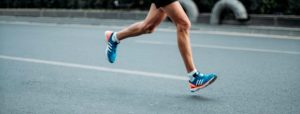Running injuries and shoe choices

Run
By Don Williams
Running injuries and shoe choices causing injuries are unfortunately are a common consequence of being a runner.
We have many patients present to IOSAS with a range of injuries as a result of running. There reasons for this are wide and variable, ranging from poor technique, through increasing load too quickly to incorrect footwear.
The reason that footwear choice is critical is that the load through our joints is magnified by running. Put simply, if a person weighs 50kgs and stands on one leg, 50kg of force goes through their foot/ankle. When they start walking, force is magnified upto 2x the load (100kg through the foot). When people run, this force magnification can be as much as 5x the original load. That means a 50kg female could easily be putting 250kg of strike force through the heel when she runs.
When the team at Institute of Sports and Spines do new patient assessments, we assess patients using video on our treadmill. We are looking at how they strike the ground with their heel as they progress in the mid-stance, how they lift the heel and toe off, looking at both bare feet and in shoes.
When we assess gait, which is the technical name for walking and running patterns, we are looking at the bio-mechanics of the foot. This can be broadly categorized as pronating foot (or rolling in) , neutral or supinating feet (rolling out). Most commonly people pronate to a degree.
With pronating feet we need controlling shoes, often with an arch support or high density foam on the instep of the shoe. Common models might be an ‘Asics’ GT2000, ‘Asics’ Kyano or a ‘Brooks’ Beast or ‘Brooks’ Ghost. This list is evidently not exhaustive.
People that supinate generally need more cushioned footwear. Recently we have seen an increase in high cushion shoes such as ‘Hokas’ and ‘Ons’ which certainly can help people with very rigid feet, often viewed as having high arches.
Importantly, cost of shoe isn’t necessarily a reflection of whether the shoe suits the foot. You could have an over pronating foot, wear a very cushioned ‘Hoka’ and end up with knee pain as a result of overload and unsupported bio-mechanics even though the shoe cost you $200. However, you might have a rigid foot and be wearing a very rigid ‘Brooks Beast’ shoe. Once again suffering from issues as a result of inappropriate foot wear as a result of poor bio-mechanics.
Some of the simple things we look at are:
For rigid high arch feet – does the person suffer when walking on concrete/tile/timber floor boards a lot? If so, we would often suggest them wearing more cushioned footwear around the house and in hard environments. This might be something simple like a ‘Croc’ , ‘Archies’ or a ‘Haviana’ Thong. These people will often report if they are wearing leather soled hard shoes like ‘RM Williams’ or strappy dress shoes or a ballet flat, that they suffer somewhat. Our advice is, wear cushier shoes.
The important take out of this is, that there is not one set of shoes that suits everyone. Our team assess bio-mechanics and suggest suitable shoes to address what your feet do. We can add exercise and activities to help with the control and bio-mechanics of the lower limb to offset any specific anatomical deficiencies or weakness that you may have.
Need further input into your foot bio-mechanics ?
Call our team today to have us run through a lower limb assessment.


Recent Comments